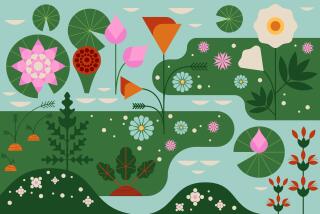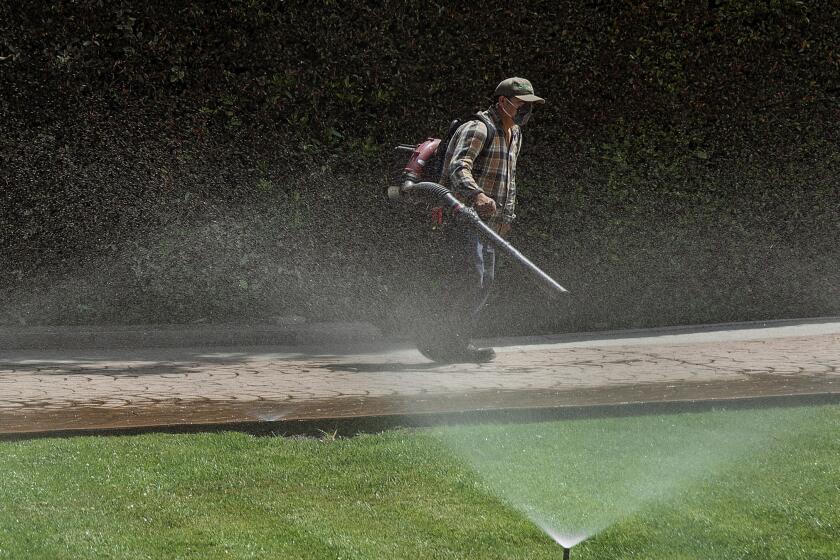Why Wait for Spring When Fall-Planting Can Really Grow on You? In the Garden
- Share via
Oct. 15, 1999 is not one of those designated Y2K days when computers might go berserk, but it is the official start of the fall-planting season (unless you live far inland, where you might be better off waiting another week or two).
From mid-October, it is considered cool enough to begin planting just about anything. Yet, the soil retains enough warmth to coax growth out of newly placed plants that otherwise might have a hard time in the chill of late December or January.
For this reason, optimum fall-planting season is considered to run between Oct. 15 and Dec. 15, but truth be told, it actually lasts well into January. I have even been known to do some “fall”-planting in February.
The logic behind an autumn-planting season is twofold. In California, the rain--if it comes at all--arrives in winter to help with the irrigation of new plantings. In addition, during the fall and winter months, the sun is so low on the horizon and the days so short that it actually takes days--and even weeks by midwinter--for the ground to dry after any watering.
So the second big benefit of fall-planting is that plants will be considerably less stressed over the next few months.
Of course, a good weeklong Santa Ana condition, with its howling dry blasts, can change all this, so you must water new plants more frequently. But even then, plants tolerate Santa Anas surprisingly well in all but the worst locales.
You can see the merits of fall-planting by comparing it to planting at the conventional time, namely spring. In the spring, plants require more water as summer approaches, bringing longer and hotter days.
*
With some plants--drought-resistant ones in particular--there’s the risk of killing them with kindness by watering too often in spring and summer. Irrigate too frequently and various diseases will rot the roots. It will appear to be wilting from lack of water, but actually is wilting from too much water and having too few healthy roots remaining.
Watering may temporarily revive rotting plants--confusing already puzzled gardeners--but more water is the last thing plants actually need. The plant has already lost too many roots, and it will die.
Plant in the fall and you avoid all this nastiness. Fall-planting is nearly infallible. I have never lost a plant put in during the autumn months--and I’ve planted literally thousands.
I’m convinced that root rots are less active in autumn, but I have been told that this is not true, so I surmise that it is easier to care for plants in autumn. I should add that I have killed many plants in late spring and summer, probably by over-watering.
If you have sprinklers installed throughout your garden, fall-planting is a little less pertinent, because you will have less trouble keeping plants watered after a spring installation. But even then, you may kill certain plans by over-watering.
There are also bound to be parts of the garden where there are no sprinklers, where you might want to plant a tree or big shrub.
Fall is probably the best time to plant trees and shrubs if you need either of these major landscape plants. They should be at the top of your “To Do” fall list.
The exceptions (there are always exceptions) would be the nearly tropical trees and shrubs, such as citrus and bougainvillea, in areas where a winter cold snap might damage a tender young evergreen. They are not going to do much growing in the chill of winter anyway so there is no advantage to planting them now.
Tropicals are more likely to sulk and die in the dreary depths of winter than they are to die of over-watering in summer, so wait until spring to plant things that love warm, balmy weather. If you think of things that would rather be growing in Hawaii than here, you will grasp what prefers being planted in spring.
Similar to subtropicals, deciduous fruit trees, such as apples and peaches and roses, might be another bunch not to plant in fall because they are such good deals bought bare root in January. There is also something to be said for planting bare root, with no container soil to contend with.
Drought-resistant plants should be No. 2 on the fall-planting list. Our own native plants or those from similar Mediterranean climates that like warm and dry weather do best when fall-planted. It might even be difficult to start them at any other time of the year.
Perennials might rate third place on your fall-planting list, except they can be so hard to find now. Some of us actually buy them at other times of the year and save them in a sideyard nursery so we can plant them in the fall, but frankly, I’ve had nearly as good luck planting perennials in early March when they are much easier to find in nurseries.
Instead of perennials, you might put ground covers in that third-place position, since they do great fall-planted. Be wary of weed seeds, however, since many sprout in the fall. But the weeds of winter tend to be annuals that are easily hoed out, while summer’s weeds seem more difficult to deal with, so this might be another plus for fall-planting.
Most herbs do exceedingly well planted in the fall, so put them in the No. 4 spot on your list of autumn activities.
Note that I have been talking about things that are fairly permanent in the garden, such as trees and ground covers. There is another kind of fall-planting--of annual flowers and vegetables--that must be done in autumn because these plants grow only during fall and winter or early spring, California’s cool season. That’s why they are often called cool-season annuals or vegetables.
*
These fall-planted, cool-season annuals confuse many gardeners from the East Coast who are in the habit of planting them in “early spring.”
You’ve seen the advice on seed packets: “Plant immediately after the last frost.” Easterners try to get things like sweet peas, calendulas and broccoli to finish up before the heat of summer knocks them flat. See the chart for a list of annuals we can plant now.
Many bulbs must also be planted in fall, because only they grow in winter and bloom in spring. There are other bulbs that one plants in spring for summer bloom, but most of the favorites are fall-planted.
So choose your weapon, bulb-planter, trowel or spade. Fall-planting is an opportunity not to be missed, and it starts bright and early tomorrow morning.
In the Garden runs Thursdays. Write to Robert Smaus, SoCal Living, L.A. Times, Times Mirror Square, L.A., CA 90053; fax to (213) 237-4712; or e-mail to robert.smaus@latimes.com.






